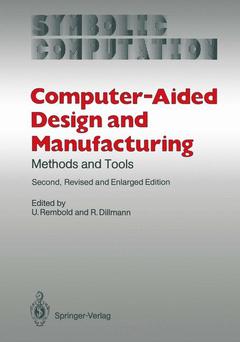Description
Computer-Aided Design and Manufacturing (2nd Ed., 2nd ed. 1986. Softcover reprint of the original 2nd ed. 1986)
Methods and Tools
Computer Graphics - Systems and Applications Series
Coordinators: Rembold U., Dillmann R.
Language: English
Subject for Computer-Aided Design and Manufacturing:
Keywords
Publication date: 12-2011
458 p. · 17x24.4 cm · Paperback
458 p. · 17x24.4 cm · Paperback
Description
/li>Contents
/li>
Manufacturing contributes to over 60 % of the gross national product of the highly industrialized nations of Europe. The advances in mechanization and automation in manufacturing of international competitors are seriously challenging the market position of the European countries in different areas. Thus it becomes necessary to increase significantly the productivity of European industry. This has prompted many governments to support the development of new automation resources. Good engineers are also needed to develop the required automation tools and to apply these to manufacturing. It is the purpose ofthis book to discuss new research results in manufacturing with engineers who face the challenge of building tomor row's factories. Early automation efforts were centered around mechanical gear-and-cam technology and hardwired electrical control circuits. Because of the decreasing life cycle of most new products and the enormous model diversification, factories cannot be automated efficiently any more by these conventional technologies. With the digital computer, its fast calculation speed and large memory capacity, a new tool was created which can substantially improve the productivity of manufactur ing processes. The computer can directly control production and quality assurance functions and adapt itself quickly to changing customer orders and new products.
1 CAD Systems and Their Interface with CAM.- 1.1 Introduction.- 1.2 Philosophy of the Application of CAD Systems.- 1.3 Software Structure of CAD Systems.- 1.4 Computer Internal Model.- 1.5 Interfaces of CAD Systems.- 1.6 Integration of the Manufacture Planning Process.- 1.7 Economic Aspects.- 1.8 Conclusion.- 1.9 References.- 1.10 Additional Literature.- 2 Design for Assembly.- 2.1 Introduction.- 2.2 Design for Assembly Philosophy.- 2.3 Determination of the Most Appropriate Process.- 2.4 Re-design for Manual Assembly.- 2.5 Re-design for Automatic Assembly.- 2.6 Robots in Manufacturing.- 2.7 Characteristics of Assembly Robots.- 2.8 Requirements for Robotic Assembly.- 2.9 Classification and Coding for Automatic Parts Handling for Flexible Assembly.- 2.10 Classification and Coding for Automatic Insertion for Flexible Assembly.- 2.11 Conclusions.- 3 Technological Planning for Manufacture — Methodology of Process Planning.- 3.1 Methodology of Process Planning.- 3.2 Development of APT and EXAPT.- 3.3 Techniques of Computer Aided Process Planning.- 3.4 Graphical Simulation of Manufacturing Processes in Process Planning.- 3.5 Systems for Computer Aided Process Planning Including Quality Control.- 3.6 The CAPSY Process Planning System.- 3.7 Planning of Assembly Sequences.- 3.8 N/C Technology.- 3.9 N/C Programming on the Shop Floor Using Graphical Simulation Techniques.- 3.10 Programming of Robots Using Graphical Techniques.- 3.11 Integrated Aspects of Technological Planning.- 3.12 References.- 4 Evolutionary Trends in Generative Process Planning.- 4.1 Introduction.- 4.2 The Principal CAPP Methodologies.- 4.3 Generative Process Planning.- 4.4 Adequacy of the Existing GPP’s in the Wake of New Developments.- 4.5 Dynamic GPP Using Pattern Recognition Techniques: A New Concept.-4.6 References.- 5 Design Methodology of Computer Integrated Manufacturing and Control of Manufacturing Units.- 5.1 Introduction.- 5.2 The Need for a Methodology and a Conceptual Model of a CIM System.- 5.3 Conceptual Model of a CIM System.- 5.4 Methods of Designing Production Control Systems.- 5.5 Design of Flexible Manufacturing Systems Using Modelling Techniques and Simulation.- 5.6 The Control of the Manufacturing Unit.- 5.7 GRAI’s Approach to Manufacturing Control.- 6 Computing Aids to Plan and Control Manufacturing.- 6.1 Hierarchical Computer Control Equipment for Manufacturing Systems.- 6.2 Hierarchical Control Architecture for Manufacturing Cells.- 6.3 Graphical Simulation Techniques for Planning and Programming of Robot Based Manufacturing Cells.- 6.4 Advanced Computer Architectures (5th Generation).- 6.5 References.- 7 Programming of Robot Systems.- 7.1 Robot Languages in the Eighties.- 7.2 Programming Languages for Manipulation and Vision in Industrial Robots.- 7.3 Programming a Vision System.- 7.4 Towards Automatic Error Recovery in Robot Programs.- 7.5 References.- 8 Present State and Future Trends in the Development of Programming Languages for Manufacturing.- 8.1 Introduction.- 8.2 Programming of Machine Tools.- 8.3 Programming Languages for Robots.- 8.4 Process Control.- 8.5 Commercial Data Processing.- 8.6 Future Trends.- 8.7 References.- 9 Quality Assurance and Machine Vision for Inspection.- 9.1 Introduction.- 9.2 Quality Assurance: Functions, Problems and Realizations.- 9.3 Machine Vision: Inspection Techniques, Mensuration and Robotics.- 9.4 References.- 10 Production Control and Information Systems.- 10.1 Strategies for the Selection of Software Packages in Production.- 10.2 Data Management Requirements for Production Control.- 10.3 PlanningStrategies for the Implementation of Production Control Systems.- 10.4 The Interface Between CAD and Production Control.- 10.5 The Interface Between Production Control and Marketing.- 10.6 Factors Influencing the Acceptance of Production Control Software.- 11 Economic Analysis of Computer Integrated Manufacturing Systems.- 11.1 Introduction.- 11.2 Process Planning.- 11.3 Capacity Analysis Using CAN-Q.- 11.4 Capital and Labour Requirements.- 11.5 Payback, Capital Cost, and Taxes.- 11.6 Cost Comparisons.- 11.7 System Efficiency.- 11.8 Justification and Automation Equipment.- 11.9 Summary.- 11.10 References.- 11.11 Appendix.- Contributors.
© 2024 LAVOISIER S.A.S.




